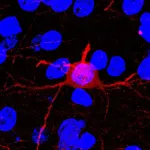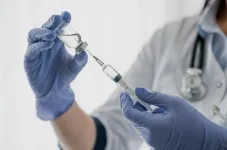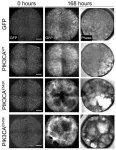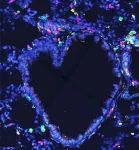Substance use disorder (SUD) is an extremely difficult disorder to overcome, and many individuals with SUD return to regular use after repeated attempts to quit.
A return to regular drug use can be caused by the body’s physical dependence on the drug as well as experiences associated with prior drug use. Exactly how these drug associations are formed in the brain and how they trigger a return to drug use remain unclear.
“Individuals make long-lasting associations between the euphoric experience of the drug and the people, places and things associated with drug use,” said Christopher Cowan, Ph.D. professor in the Department of Neuroscience at the Medical University of South Carolina (MUSC) and member of the Brain and Behavior Research Foundation Scientific Council.
Cowan and his team report in the Proceedings of the National Academy of Sciences (USA) that an enzyme known as histone deacetylase 5, or HDAC5, plays a significant role in limiting heroin-associated memories and drug-seeking behavior following a period of abstinence in rats.
The study, funded by the National Institute on Drug Abuse (NIDA), reveals HDAC5 as a target of interest in treating vulnerability to return to drug use in opioid use disorder.
HDAC5 is an “epigenetic” enzyme, meaning it can influence the expression of many different genes. HDAC5 is active in the brain and has been associated previously with resumed cocaine use after a period of abstinence.
“In a prior study, we showed that HDAC5 is regulated by cocaine, and it reduces the impact of substance use triggers following cocaine use,” said Cowan. “In the new study, we wanted to learn why HDAC5 had these effects and if they were specific to cocaine or perhaps generalizable to other classes of addictive drugs, like opioids.”
Cowan examined drug-seeking behaviors by modelling a return to opioid use in rats after a period of abstinence from self-administration of heroin, a commonly used opioid drug.
First, rats were given the opportunity to self-administer heroin by pressing a lever. At the same time, they were presented with visual and audio cues that they associated with their heroin use.
Then, after 2-3 weeks of daily heroin use, the rats went through a week of abstinence before being placed back in the environment where they formerly used heroin. This drug-associated “place” triggered the pressing of the lever, or heroin seeking, but in this case no heroin was delivered.
Later, drug-seeking behavior was stimulated in the rats by exposing them to the visual and audio cues formerly linked to their heroin use.
Finally, the rats were given a small dose of heroin to remind them of the feeling of the drug, and again, this stimulated vigorous heroin seeking.
“By seeing how many times the rats press the lever while not getting the drug, we can measure the strength of the drug-use context, the drug-associated memory cues or the re-exposure to physiological drug effects to promote return to heroin use,” explained Cowan.
To see how HDAC5 controlled drug-seeking behavior after a period of abstinence, Cowan’s lab used a molecular trick to either increase or decrease the levels of HDAC5 in the nucleus, or DNA-containing site, of their targeted brain cells.
Rats with lower HDAC5 showed enhanced heroin seeking when exposed to triggers, while rats with higher HDAC5 showed reduced heroin-seeking behavior. This finding showed that the epigenetic enzyme HDAC5 plays a critical role in modulating the power of drug-associated memories and preventing a return to drug use.
“We found that HDAC5 limits heroin-associated cues and opposes the powerful nature of these drug cues to trigger drug-seeking behavior,” said Cowan. “This suggests that, in the brain, HDAC5 functions to influence the formation and strength of these drug memories that can promote a return to drug use.”
To ensure that their findings were specific to drug-seeking behavior and not just general reward seeking, Cowan’s lab repeated the same experiment but used sucrose instead of heroin. Sucrose is a simple sugar that rats enjoy consuming and serves as a natural reward.
“There was absolutely no effect of HDAC5 on sucrose-seeking behavior,” said Cowan. “So, it seems that addictive drugs, like cocaine and heroin, are engaging HDAC5 in a way that is separate from our natural reward learning and memory process.”
After observing the effects of HDAC5 on drug-seeking behavior, Cowan’s lab investigated what genes HDAC5 was actually controlling.
“We found hundreds of genes affected by HDAC5,” said Cowan. “But a large number of the genes are linked to ion channels that influence the excitability of neuronal cells in the brain.”
Rats with higher levels of HDAC5 had much less excitable neurons than those with low HDAC5, showing that the enzyme has a suppressive effect.
“The firing suppression from HDAC5 is likely a key underlying mechanism controlling the formation and strength of drug-associated memories,” said Cowan.
With a better understanding at a molecular level of drug addiction and return to drug use, scientists and physicians can develop targeted therapies to treat SUD. Future studies in Cowan’s lab aim to leverage HDAC5 to make the road to recovery less challenging.
“We have uncovered a mechanism in the brain that is controlling the formation and maintenance of really powerful and enduring drug-cue associations,” said Cowan. “We want to translate these findings to the clinic and help individuals with substance use disorder by reducing vulnerability to return to regular drug use.”
# # #
This research is supported by the National Institute on Drug Abuse of the National Institutes of Health under award numbers 5P50DA046373-04, P50DA046373, 5K01DA046513, R01DA054589, and F32DA047845. The content presented in this release is solely the responsibility of the authors and does not necessarily represent the official views of the National Institutes of Health.
About MUSC
Founded in 1824 in Charleston, MUSC is the state’s only comprehensive academic health system, with a unique mission to preserve and optimize human life in South Carolina through education, research and patient care. Each year, MUSC educates more than 3,000 students in six colleges – Dental Medicine, Graduate Studies, Health Professions, Medicine, Nursing and Pharmacy – and trains more than 850 residents and fellows in its health system. MUSC brought in more than $297.8 million in research funds in fiscal year 2022, leading the state overall in research funding. For information on academic programs, visit musc.edu.
As the health care system of the Medical University of South Carolina, MUSC Health is dedicated to delivering the highest quality and safest patient care while educating and training generations of outstanding health care providers and leaders to serve the people of South Carolina and beyond. Patient care is provided at 14 hospitals with approximately 2,500 beds and five additional hospital locations in development, more than 350 telehealth sites and connectivity to patients’ homes, and nearly 750 care locations situated in all regions of South Carolina. In 2022, for the eighth consecutive year, U.S. News & World Report named MUSC Health the No. 1 hospital in South Carolina. To learn more about clinical patient services, visit muschealth.org.
MUSC and its affiliates have collective annual budgets of $5.1 billion. The nearly 25,000 MUSC team members include world-class faculty, physicians, specialty providers, scientists, students, affiliates and care team members who deliver groundbreaking education, research and patient care.
END






